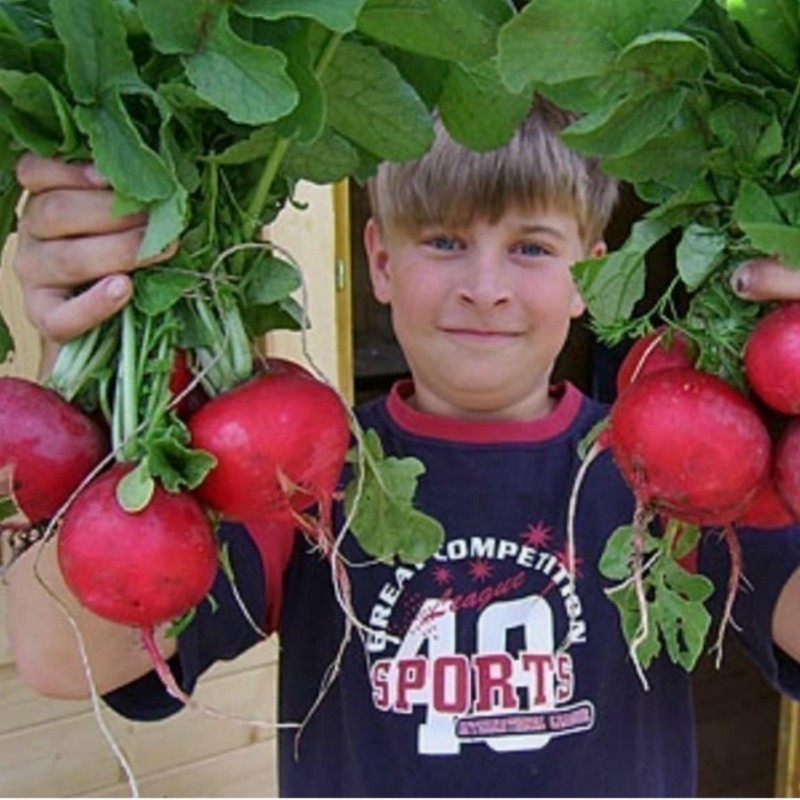- −15%

Jätteväxt (med gigantiska frukter)





Solid white flesh is firm, crisp and mild. Globe-shaped roots have deep crimson skin, and reach 10cm in diameter, without becoming hollow or pithy. Solid white flesh is firm, crisp and mild. Ready to harvest 29 days after seeding.
GARDEN HINTS: Thrives in cool weather. Make successive plantings every 2 weeks until late spring, then again a month before frost.
Sun: Full Sun
Spread: 3 inches
Height: 4-6 inches
Thinning: 3 inches
Days to Maturity: 30 days
Sowing Method: Direct Sow
WIKIPEDIA:
Rädisa (Raphanus sativus var. sativus) är en ett- eller tvåårig ört i familjen korsblommiga växter. Bladen sitter i en rosett och är flikigt ovala. Rädisans uppsvällda stamknöl[1] äts som grönsak.
Ursprung
Det är okänt var rädisan ursprungligen kommer från. Den har länge odlats som kulturväxt i Kina och Japan. Romarna kände till växten vid vår tideräknings början. På 1500-talet kom rädisan till Nordeuropa och den har odlats i Sverige sedan 1600-talet. Den finns dokumenterad i Hovförtäringen 1636. Den blev emellertid inte vanlig som kulturväxt i Sverige förrän på 1800-talet.
Rädisa som grönsak
Rädisan skördas genom att man drar upp den ur jorden, precis som med morötter. Det är vanligtvis stamknölen som äts, men även blasten kan användas som salladsblad, finhackad eller tillagad. Rädisor är ofta runda och skarpt röda utanpå och vita inuti och äts vanligtvis råa. De varierar i utseende beroende på sort. Det finns avlånga, runda, helt röda, rödvita eller helt vita rädisor. Dessutom finns sorter där man äter fröbaljorna. Rädisor kan ha en ganska stark smak, vilken beror på senapsoljor som framförallt finns i de yttersta lagren. Rädisor skördas tidigt; står de länge blir de träiga. De äts vanligen färska eller hastigt kokta.
Rädisor innehåller näringsämnen som natrium, vitamin C och kostfiber.
Rädisor kan odlas i växthus och finns därför vanligen färska året om i handeln. De saluförs endera i knippen eller i plastpåsar med blasten bortrensad. Rädisor för export odlas bland annat i Nederländerna och i Israel.
Datablad
Radishes are a hardy, easy-to-grow root vegetable that can be planted multiple times in a growing season.
Here’s how to plant and grow radishes in your garden!
Radish seeds can be planted in both the spring and the fall, but growth should be suspended in the height of summer when temperatures are typically too hot. (Hot temperatures may cause radishes to bolt, making them essentially useless.)
Otherwise, radishes are one of the easiest vegetables to grow.
Plant in a sunny spot. If radishes are planted in too much shade—or even where neighboring vegetable plants shade them—they will put all their energy into producing larger leaves.
Like carrots, radish plants are primarily grown for their roots. Though the soil needs to be rich in organic matter, it should not be compacted. If your soil is more clay-like, mix in some sand to loosen it and improve drainage.
If your soil isn’t rich in organic matter, incorporate a few inches of aged compost or all-purpose fertilizer (see packaging for amount) into the planting site as soon as the soil is workable.
Till your garden bed to remove any rocks or dirt clods before planting.
Practice three-year crop rotation. In other words, only plant radishes in the same spot every third year. This will help prevent diseases from affecting your crop.
For a spring planting, sow seeds 4–6 weeks before the average date of the last frost. See local frost dates here.
It’s best to plant radish seeds directly in the garden so as not to disturb their roots. Directly sow seeds outdoors 2 cm deep and 2,5 cm apart in rows 28 cm apart.
Plant another round of seeds every 10 days or so—while weather is still cool—for a continuous harvest of radishes in the late spring and early summer.
Plan on a fall planting. You can plant radishes later than any other root crop in late summer or early fall and still get a harvest. Sow seeds 4–6 weeks before the first fall frost.
Thin radishes to about 2 inches apart when the plants are a week old. Crowded plants do not grow well.
Consistent, even moisture is key. Keep soil evenly moist but not waterlogged. A drip irrigation system is a great way to achieve this.
Putting a thin layer of mulch around the radishes can help retain moisture in dry conditions.
Radishes will be ready to harvest quite rapidly, as soon as three weeks after planting for some varieties.
For most varieties, harvest when roots are approximately 2,5 cm in diameter at the soil surface. Pull one out and test it before harvesting the rest!
Do not leave radishes in the ground long after their mature stage; their condition will deteriorate quickly.
Cut the tops and the thin root tail off, wash the radishes, and dry them thoroughly. Store in plastic bags in the refrigerator.
Radish greens can be stored separately for up to three days.
Radish seeds have a fairly long shelf life. Don’t be afraid to plant radish seeds that are up to five years old. All may not germinate, but you’ll have plenty that will.

 Reviews (0)
Reviews (0)